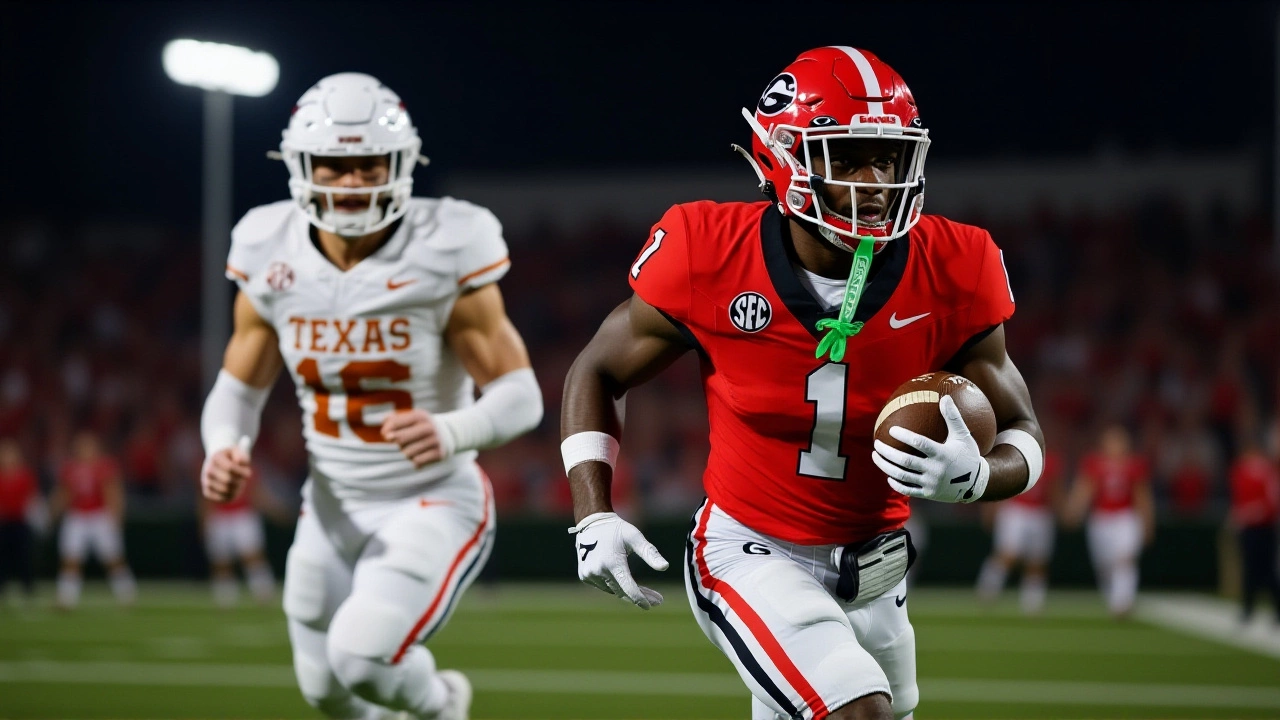The College Football Playoff Selection Committee dropped its third rankings of the 2025 season on Tuesday, November 18, 2025, and the landscape shifted dramatically—especially for teams on the bubble. Ohio State stayed put at No. 1, undefeated at 10-0, while Indiana (11-0) clung to No. 2 and Texas A&M (10-0) held firm at No. 3. But the real story? Alabama tumbled from No. 4 to No. 10 after a shaky performance against LSU. One analyst called it "a freefall," and fans in Tuscaloosa are already wondering if the Crimson Tide’s playoff dreams are slipping away.
Who Moved Up—and Who Got Left Behind?
The rankings released at 8:00 PM UTC showed more movement than any previous week this season. Georgia climbed from No. 5 to No. 4 after a dominant win over Florida. Texas Tech jumped to No. 5, replacing Notre Dame, which fell from No. 7 to No. 9 after a close loss to Oklahoma State. Oklahoma rose to No. 8, narrowly edging out Oregon, a matchup that sparked heated debate on the CFP’s live YouTube feed. "I don’t know that they should be above Oregon," one commentator muttered, referencing the Sooners’ two losses and Oregon’s tougher schedule. The committee didn’t clarify, but their decision speaks volumes.Meanwhile, Alabama’s drop to No. 10 was the most jarring. After starting the season as a top-three contender, the Tide lost to LSU and barely survived against Mississippi State. "They’re going to stay inside of the playoff, but they’re going to be like that last team in," said ESPN analyst Sam Brown during the live reveal. That’s a dangerous spot. One slip in the final two weeks, and Alabama could be watching the playoffs from home.
The 12-Team Format Is Changing Everything
This is only the second season of the expanded 12-team playoff, and it’s already reshaping how teams approach the regular season. No longer is it just about winning your conference. It’s about strength of schedule, head-to-head results, and avoiding embarrassing losses. Indiana, for example, is 11-0 but plays in the Big Ten East—a division with no top-10 teams besides itself. Yet the committee hasn’t punished them. Why? Because they’ve beaten every opponent by at least 17 points. They’re not just winning—they’re dominating.That’s the new standard. Utah (8-2) is ranked No. 12 despite two losses, because both came against top-5 teams. BYU (9-1) sits at No. 11, the highest-ranked independent, thanks to a win over Notre Dame and a schedule that includes three Power Five opponents. The old system—where conference champions got automatic bids—is gone. Now, it’s pure merit.

Who’s Still in Control?
The top three—Ohio State, Indiana, and Texas A&M—are in the driver’s seat. But they’re not invincible. Ohio State faces Michigan next week. Indiana has to close out against Purdue and Penn State. Texas A&M’s final two games? LSU and Arkansas. One slip, and the entire bracket could flip.Meanwhile, the teams fighting for the last few spots are playing like their season depends on it. Notre Dame and Alabama need wins and help. Oklahoma and Oregon are in a de facto tiebreaker battle. And then there’s Arizona State, ranked No. 25, whose quarterback Sam Levit announced his transfer this week—adding chaos to an already unpredictable race.
What Happens Next?
The next rankings drop on Tuesday, November 25, 2025, just after Thanksgiving. That’s when the real drama begins. Teams with conference title game implications—like Michigan vs. Ohio State—will have their fates decided in front of millions. The final rankings, on December 7, 2025, will be broadcast live on ESPN from 7:00 PM Eastern. That’s when the 12-team bracket is revealed, including first-round matchups on campus sites on December 20 and 21.The championship game? That’s set for Monday, January 20, 2025, at Mercedes-Benz Stadium in Atlanta. The stakes? A national title. The pressure? Unrelenting.

The Committee’s Secret Weapon
The College Football Playoff Selection Committee, chaired by Warde Manuel, athletic director at the University of Michigan, has 13 members—each with a background in coaching, administration, or media. They meet in person every Tuesday, reviewing film, stats, and head-to-head results. They’re not supposed to care about polls or fan opinions. But they’re human. And as the YouTube commentary showed, even they struggle to agree on Oregon vs. Oklahoma.One thing’s clear: the committee values wins over resume-building. A 10-1 team that beat two top-10 opponents will beat a 10-1 team that beat three bottom-tier teams. That’s why Texas Tech jumped over Notre Dame—their win over Oklahoma mattered more than the Fighting Irish’s win over a ranked but fading Clemson.
Frequently Asked Questions
Why is Indiana ranked higher than Ohio State despite having one more loss?
Indiana isn’t ranked higher—they’re actually 11-0, while Ohio State is 10-0. Indiana’s perfect record gives them the edge, and their schedule, while less nationally prominent, includes wins over ranked opponents like Iowa and Wisconsin. The committee values undefeated records above all, especially when the team dominates opponents. Ohio State’s schedule is tougher, but Indiana’s consistency has earned them the No. 2 spot.
Can Alabama still make the playoff with a loss in their final two games?
It’s possible, but unlikely. At No. 10, Alabama needs help. They’d have to win out, and at least two teams ahead of them—like Oklahoma, Oregon, or Notre Dame—would need to lose. The committee has shown they won’t reward teams with multiple losses unless they’ve beaten top-tier opponents. Alabama’s two losses this season were to LSU and Mississippi State, neither of whom are currently ranked. That’s a tough row to hoe.
How does the 12-team format change the importance of conference championships?
It reduces their automatic value. In the old four-team system, winning your conference almost guaranteed a spot. Now, the top four teams get byes, and the rest are seeded by merit. A non-champion like BYU or Oklahoma State can still make it if they’re ranked high enough. But winning your conference still helps—it gives you a resume boost and often a win over a ranked opponent. It’s not a ticket, but it’s a strong boost.
When will the full playoff bracket be revealed?
The full 12-team bracket, including first-round matchups and home-field advantages, will be revealed on Tuesday, December 7, 2025, during a two-hour ESPN broadcast starting at 7:00 PM Eastern. The committee waits until that moment to finalize seeding based on the final rankings, conference championship outcomes, and any late-season upsets. First-round games are scheduled for December 20 and 21 at the higher-seeded team’s campus.
Why is Oregon ranked below Oklahoma despite having a better record?
Oregon is 9-1, Oklahoma is 8-2. But the committee looks beyond wins and losses. Oklahoma’s two losses came against top-10 teams (Texas and Kansas State), while Oregon’s loss was to unranked USC. Oklahoma also has a win over No. 5 Texas Tech, and their strength of schedule ranks higher. The committee doesn’t love Oregon’s non-conference slate, which included several lower-tier opponents. That’s why they’re ranked behind the Sooners.
What role does the quarterback transfer news play in the rankings?
It doesn’t directly affect the rankings. The committee evaluates teams based on on-field performance through the most recent games. But the transfer of Arizona State’s Sam Levit signals instability in a program that’s barely ranked. It may influence how the committee views Arizona State’s future potential, but not their current standing. Still, it adds narrative weight—especially for teams on the bubble, where perception can matter as much as stats.
